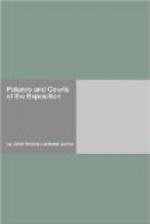It is suggestive of the last period of English Gothic in its rich parallelism of vertical line — and yet is not that.
It is suggestive of the flamboyant decoration of the French architecture such as one sees and feels at Rouen Cathedral — and yet, not that, for on looking closer one sees not wavy line suggesting flame, but the wave of the kelp of the sea — and then one realizes that the vertical lines represent falling water.
The kelp is turned, looped and suspended with all sorts of lobsters, crabs, sea-turtles, octopi, flounders, etc., wriggling thru it, not seen at first, then in strong evidence, making you wonder why you had not seen them before.
The whole cloister represents the magical power of water and fire worked out in travertine, fountains and illuminations.
This court certainly shows the most marked originality in the architectural line at the Exposition. It is the conception of a man of rare invention, imagination, and marked poetic feeling. It is surely the last word in stucco. Everybody loves this Court of the Ages, and everybody wishes that we could have something permanent like it somewhere — perhaps in San Francisco. We shall all be loath to part with in when the two hundred and eighty-eight days are gone.
The arches of perfect proportions are allowed two swinging fairy lanterns apiece — a soft glow coming from them.
In the corridors are globes which at night look like lambent moonstones, casting soft light.
Walk down the corridors (not noticing the glorious murals at the ends) to observe the fine manipulation of color.
Notice that the usual pink of the walls has here a deeper tone — a terra-cotta warmth added, making a most wonderful combination with the blue vault above. The arches are of smoked ivory. Your eye catches a line of cerulean blue at your side, and up you follow the blue, until it gains its fullest expression in the square area of the groined vaulting. Notice how bands of smoked ivory play the part of transverse arches. It is so very beautiful here.
The murals in this corridor are more wonderful than words can tell. They are by Frank Brangwyn of London, and represent Earth, Air, Water, Fire.
Earth — Two canvases represent the Earth, the teeming, opulent earth giving of its fullness. Men with great baskets gather the harvests of vegetables and fruits (especially the luscious grapes in the second canvas).
Fire — One canvas shows Primitive Fire, where by means of leaves and twigs the narrow curl of smoke ascends between the trees. Men on bended knees blow the slowly burning leaves and fan the flame.
The aged draw near to feel the warmth; nearer comes the man with the little child in his arms — and, as a result, we have a homely woodland scene of primitive times.
The second representation of the same subject glows on the next canvas.
The subject is Industrial Fire. Men have made a rude furnace in which the pots are being baked. Pots of all sizes and shapes are being brought by the men and women of the neighboring region.




